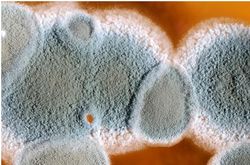The manufacturer of ventilation and air conditioning demand for sealing and bonding of air filters built in their systems special hygiene requirements for air conditioning systems (HVAC systems) and Device according to VDI meet 6022.
The Sonderhoff Chemicals GmbH offered antimicrobial foam seals to their international customers already for several years, and has since optimized its sealing systems continuously. Special additives ensure the seal formulation for protection against harmful microorganisms that can become lodged on the seals in an unfavourable indoor climate. Therefore, manufacturers of technical equipment and air filters increasingly ask Sonderhoff for antimicrobial sealing solutions.
It is known that hot humid climates, as it prevails in ventilation and air conditioning systems for the exchange of incoming and dissipated fresh air, promote bacterial growth. Specifically at increasing temperatures, the concentration of microorganisms increase and the fungal spores develop a higher vitality. Such conditions are a good breeding ground for germs and diseases that can cause infections in humans. Therefore, the market for air conditioning systems requires special seals with a surface on which microorganisms, such as molds and fungal spores, cannot arise.
The fact that the German Federal Government, the recasting of the Infection Protection Act (Printed Matter 17/5178, which has been adopted by the Bundestag on 09.06.2011) and the ensuing measures for hygiene improvement, has declared war against germs, and thus pathogens, shows the extent of the problem and its consequences for society.
Against this background, the importance of the mechanical ventilation of interior spaces through air handling (HVAC) systems, i. e. the use of air conditioners and their quality standards, has newly been discussed. Specifically, the air filter of this equipment, which are intended to improve the climatic conditions of interiors, stand out in the public focus as major risk factors for contamination of indoor air.
In this context, infections transmitted with the room air are observed as a cause of adverse reactions and infectious diseases in humans and animals increasingly - also known as the "sick building syndrome". As a reason for this can be seen, the separation of dust and biogenic constituents as well as the accumulation of living and dead microorganisms on air filters in air conditioners, which can lead to health-related burden of indoor air.
Ventilation systems must therefore function properly because the accumulation of micro-organisms held on air filters may represent a potent allergen reservoir. To ensure hygienic standards of HVAC systems regular technical and hygienic controls are therefore necessary. Amongst these measures, the leak-free seat of air filters is checked by optimal seals, which are provided, at best, with an antibacterial protection.
Sonderhoff foam seals suitable for use in HVAC systems
The Institute for Air Hygiene (ILH Berlin) has currently tested selected foam seal systems from Sonderhoff Chemicals and recognized them as suitable for the use in HVAC systems. are the foam seal systems FERMAPOR® K31-A-9020-17F and K31-A-9308-5-VP5-F and the potting system FERMADUR® A-196-4F especially developed for HVAC systems have been examined in their resistance to fungi and bacteria according to DIN EN ISO 846 (Evaluation of the action of microorganisms on plastics). These systems also meet the requirements for microbial inertness of the VDI 6022 (test for microbial metabolic potential, Part 1 (04/2006). The test results show that the sealing material is not used as a nutrient source for microorganisms.
The FERMAPOR® foam seals with antibacterial features protect the plastic surfaces of the air technical components for air distribution, such as ventilation grilles, air filter, nebulizers and access locks, effectively against attacks by allergens and bacterial microorganisms that can settle on them.
They are distinguished by a high tensile strength and low water absorption and can be processed precisely to contours with inclines and declines even with complex, three-dimensional components. On painted or powder-coated metal surfaces they have an optimal adhesion.

